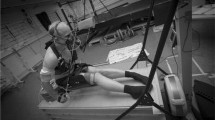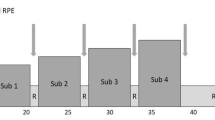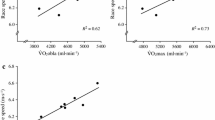Summary
Seven female and eight male elite junior skaters performed cycle ergometer tests at four different times during the 1987/1988 season. The tests consisted of a Wingate-type 30-s sprint test and a 2.5-min supramaximal test. The subjects were tested in February, May and September 1987 and in January 1988. Maximal oxygen consumption was measured during the 2.5-min test. With the exception of the maximal oxygen consumption of the women in May which was about 6% lower than in the other three tests, no seasonal changes in the test results could be observed —this, in spite of a distinct increase in training volume (from 10 to more than 20 h · week−1) and training intensity in the course of the season. When the test data were compared to those of elite senior skaters, it appeared that the junior skaters showed the same values for mean power output during the sprint test [14.2 (SD 0.4) W · kg−1 for the men and 12.6 (SD 0.5) W · kg−1 for the women] and maximal oxygen consumption [63.1 (SD 2.8) ml· kg−1 · min−1 for the men and 55.3 (SD 3.5 ml · kg−1 · min−1 for the women, respectively] as found for senior skaters. It seemed, therefore, that the effects of training in these skaters had already levelled off in the period before they participated in this investigation. In contrast to previous studies, no relationship could be shown between the test results and skating performance. This was most likely due to the homogenous character of the groups (mean standard deviations in power and oxygen consumption were only 5%). It was concluded that the present cycle tests used to measure aerobic and anaerobic power were obviously not of use in evaluating seasonal changes in performance in these groups of highly trained athletes.
Similar content being viewed by others
References
Boer RW de, Nilsen KL (1989) The gliding and push off technique of male and female speed skaters. Int J Sports Biomech 5:119–134
Dickhuth HH, Wohlfahrt B, Hildebrand D, Rokitzki L, Huonker M, Keul J (1988) Jahreszyklische Schwankungen der Ausdauerleistungsfahigkeit von hochtrainierten Mittelstreckenläufern. Dtsch Z Sport Med 39:346–353
Ekblom B, Hermansen L, Saltin B (1967) Idrottsfysiologi. Rapport no. 5. Framtiden, Stockholm
Fagard R, Bielen E, Amery A (1991) Heritability of aerobic power and anaerobic energy generation during exercise. J Appl Physiol 70:357–362
Foster C, Snyder AC, Thompson NN, Kuettel KK, Conway MJ (1989) Cycle ergometry during training for speed skating. J Appl Sport Sci Res 3:79–84
Foster C, Thompson NN, Snyder AC (1990) Physiology of speed skating. University of Wisconsin Medical School, Milwaukee, Wis.
Gemser H, Ingen Schenau GJ van (1987) Handboek Wedstrijdschaatsen (in Dutch). Eisma, Leeuwarden
Geijsel J, Bomhoff G, Velsen J van, Groot G de, Ingen Schenau GJ van (1984) Bicycling ergometry and speed skating performance. Int J Sports Med 5:241–245
Groot G de, Boer RW de, Ingen Schenau GJ van (1985) Power output during cycling and speed skating. In: Winter DA, Norman RW, Wells RP, Hayes KC, Patla AE (eds) Biomechanics IX. Human Kinetics, Champaign, Ill., pp 555–559
Gullstrand L, Holmer I (1983) Physiological characteristics of champion swimmers during a five-year follow up period. In: Hollander AP, Huying PA, Groot G de (eds) Biomechanics and medicine in swimming. Human Kinetics, Champaign, Ill., pp. 258–262
Ingen Schenau GJ van (1982) The influence of air friction in speed skating. J Biomech 15:449–458
Ingen Schenau GJ van, Groot G de (1983a) Differences in oxygen consumption and external power between male and female speed skaters during supra maximal cycling. Eur J Appl Physiol 51:337–345
Ingen Schenau GJ van, Groot G de (1983b) On the origin of differences in performance level between elite male and female speed skaters. Hum Movement Sci 2:151–159
Ingen Schenau GJ van, Groot G de, Hollander AP (1983) Some technical, physiological and anthropometrical aspects of speed skating. Eur J Appl Physiol 50:343–354
Ingen Schenau GH van, Groot G de, Boer RW de (1985) The control of speed in elite female speed skaters. J Biomech 18:91–96
Ingen Schenau GJ van, Boer RW de, Geijsel JSM, Groot G de (1988) Supramaximal test results of male and female speed skaters with particular reference to methodological problems. Eur J Appl Physiol 57:6–9
Ingen Schenau GJ van, Koning JJ de, Groot G de (1990) A simulation of speed skating performances based on a power equation. Med Sci Sports Exerc 22:718–728
Kloosterboer T (1987) Praktijk trainingsleer. In: Gemser H, Ingen Schenau GJ van (eds) Handboek Wedstrijdschaatsen (in Dutch). Eisma, Leeuwarden
Koning JJ de (1991) Biomechanical aspects of speed skating. Thesis, Free University, Amsterdam
Koning JJ de, Groot G de, Ingen Schenau GJ van (1989) Mechanical aspects of the sprint start in olympic speed skating. Int J Sport Biomech 5:151–168
Maksud MG, Wiley L, Hamilton LH, Lockhart B (1970) MaximalV 2, ventilation and heart rate of Olympic speed skating candidates. J Appl Physiol 29:186–190
Murase Y, Kobayashi K, Kamei S, Matsui H (1991) Longitudinal study of aerobic power in superior junior athletes. Med Sci Sports Exerc 13:180–184
Nemoto I, Iwaoka K, Funato K, Yoshioka N, Miyashita M (1988) Comparisons of aerobic threshold, anaerobic threshold and maximal oxygen uptake of sprint and endurance trained speed skaters. J Med Soc Toho 34:347–352
Paterson DH, McLellan TM, Stella RS, Cunningham DA (1987) Longitudinal study of ventilation threshold and maximal Oz uptake in athletic boys. J Appl Physiol 62:2051–2057
Rusko H (1987) The effect of training on aerobic power characteristics of young cross country skiers. J Sport Sci 5:273–286
Author information
Authors and Affiliations
Rights and permissions
About this article
Cite this article
van Ingen Schenau, G.J., Bakker, F.C., de Groot, G. et al. Supramaximal cycle tests do not detect seasonal progression in performance in groups of elite speed skaters. Europ. J. Appl. Physiol. 64, 292–297 (1992). https://doi.org/10.1007/BF00636214
Accepted:
Issue Date:
DOI: https://doi.org/10.1007/BF00636214




